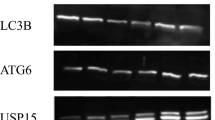Abstract
Arsenic trioxide is highly effective in the treatment of acute promyelocytic leukemia (APL). In September 2000, the Trisenox brand of arsenic trioxide for the treatment of relapsed and refractory APL was approved in the United States. Arecent clinical report has shown a serious ventricular tachycardia at the therapeutic doses of arsenic trioxide in APL patients. The present study was undertaken to investigate the cardiotoxic effect of arsenic trioxide using a mouse model. Animals were injected intraperitoneally with arsenic trioxide 5 mg/kg/d for 30 d, a dose regiment that has been shown to produce plasma concentrations of arsenic within the range of those present in arsenic-treated APL patients. Analysis of myocardial function revealed that arsenic caused a significant decrease in the maximum rate of rise in intraventricular pressure during ventricular contraction (MAX dP/dt), and significant increases in the end diastolic pressure and ventricle minimum diastolic pressure. In response to β-adrenergic stimulation by isoproterenol, the arsenic-treated heart did not show increase in MAX dP/dt, which was observed as a stress response in the saline-treated controls. The functional alterations were accompanied by cardiomyopathy, as revealed by histopathological and ultrastructural examination. Furthermore, arsenic caused myocardial apoptosis, as determined by a terminal deoxynucleotidyl transferase-mediated dUTP nick-end labeling assay, which was confirmed by caspase-3 activation detected by enzymatic assay. Our study thus demonstrates that arsenic trioxide, in a dose that could produce clinically comparable serum concentrations to those observed in humans, causes cardiotoxicity.
Similar content being viewed by others
References
Hindmarsh, J.T. and McCurdy, R.F. (1986). Clinical and environmental aspects of arsemic toxicity. Crit. Rev. Clin. Lab. Sci. 23:315–347.
Lerda, D. (1994). Sister-chromatid exchange (SCE) among individuals chronically exposed to arsenic in drinking water. Mutat. Res. 312:111–120.
Dong, J.T. and Luo, X.M. (1994). Effects of arsenic on DNA damage and repair in human fetal lung fibroblasts. Mutat. Res. 315:11–15.
Kipling, B.C. (1978). Arsenic and cancer. J. Soc. Occup. Med. 28:3–5.
Treleaven, J., Meller, S., Farmer, P., Birchall, D., Goldman, J., and Piller, G. (1993). Arsenic and Ayurveda. Leuk. Lymphoma 10:343–345.
Chen, Z.Y., Liu, T.P., and Yang, Y. (1995). Manual of Clinical Drugs. Shanghai Science and Technology Shanghai.
Forkner, C., and McNair-Scott, T.F. (1931). Arsenic as a therapeutic agent in chronic myeloid leukemia. JAMA 97: 305–308.
Kuzoe, F.A. (1993). Current situation of African trypanosomiasis. Acta Trop., 54:153–162.
Sun, H.D., Ma, L., Hu, X.C., and Zhang, T.D. (1992). Ai-Lin I treated 32 cases of acute promyelocytic leukemia. Chin. J. Integrat. Chinese Western Med. 12:170–172.
Singer, J.W. (2001). Cardiac toxicity of arsenic trioxide. Blood 98:1633.
Shen, Z.X., Chen, G.Q., Ni, J.H., Li, X.S., Xiong, S.M., Qiu, Q.Y., et al. (1997). Use of arsenic trioxide (As2O3) in the treatment of acute promyelocytic leukemia (APL): II. Clinical efficiency and pharmacokinetics in relapsed patients. Blood 89:3354–3360.
Unnikrishnan, D., Dutcher, J.P., Varshneya, N., Lucariello, R., Api, M., Gari, S., et al. (2001). Torsades de pointes in 3 patients with leukemia treated with aresenic trioxide. Blood 97:1514–1516.
Goldsmith, S. and From, A. H. L. (1980). Arsenic-induced atypical ventricular tachycardia. N. Engl. J. Med. 303: 1096–1102.
Westervelt, P., Brown, R.A., Adkins, D.R., Khoury, H., Curtin, P., Hurd, D., et al. (2001). Sudden death among patients with acute promyelocytic leukemia treated with arsenic trioxide. Blood 98:266–271.
Lallemand-Breitenbach, V., Guillemin, M.C., Janin, A., Daniel, M.T., Degos, L., Kogan, S.C., et al. (1999). Retinoic acid and arsenic synergize to eradicate leukemic cells in a mouse model of acute promyelocytic leukemia. J. Exp. Med. 189:1043–1052.
Lorenz, J.N. and Robbins, J. (1997) Measurement of intraventricular pressure and cardiac performance in the intact closed-chest anesthetized mouse. Am. J. Physiol. 272: H1137-H1146.
Kang, Y.J., Chen, Y., Yu, A., Voss-McCowan, M., and Epstein, P.N. (1997). Overexpression of metallothionein in the heart of transgenic mice suppresses doxorubicin cardiotoxicity. J. Clin. Invest. 100(6):501–1506.
Yang, S.S., Bentivoglio, L.G., Maranhao, V., and Goldgerg, H. (1972) From Cardiac Catheterization Data to Hemodynamic Parameters. F. A. Davis, Philadelphia.
Jing, Y.K., Dal, J., Chalmers-Redman, R.M.E., Tatton, W.G. and Waxman, S. (1999). Arsenic trioxide induces acute promyelocytic leukemia cell apoptosis via a hydrogen peroxide-dependent pathway. Blood 94:2102–2111.
Chen, Z., Chen, G.Q., Shen, Z.X., Chen, S.J., and Wang, Z.Y. (2001). Treatment of acute promyelocytic leukemia with arsonic compounds: In vitro and in vivo studies. Semin. Hematol. 38:26–36.
Li, P., Nijhawan, D., Budihardjo, I., Srinvasula, S.M., Ahmand, M., Alnermri, E.S., et al. (1997). Cytochrome c and dATP-dependent formation of apaf-1/casapase-9 complex initiates an apoptotic protease cascade. Cell 91:479–489.
Liu, X., Kim, C.N., Yang, J., Jemmerson, R., and Wang, X. (1996). Induction of apoptotic program in cell-free extracts: requirement for dATP and cytochrome c. Cell 86: 147–157.
Tafani, M., Schneider, T.G., Pastorino, J.G., and Farber, J.L. (2000). Cytochrone c-dependent activation of caspase-3 by tumor necrosis factor requires induction of the mitochondrial permeability transition. Am. J. Pathol. 156:2111–1121.
Tian, R.H., Zhang, G.Y., Yan, C.H., and Dai, Y.R. (2000). Involvement of poly (ADP-ribose) polymerase and activation of caspase-3-like protease in heat shock-induced apoptosis in tobacco suspension cells. FEBS Lett. 474:11–15.
Datta, R., Banach, D., Kojima, H., Talanian, R.V., Alnermri, E.S., and Wong, W. W. (1996). Activation of the CPP32 protease in apoptosis induced by 1-β-d-arabinofuranosylcytosine and other DNA-damaging agents. Blood 88:1936–1943.
Author information
Authors and Affiliations
Corresponding author
Rights and permissions
About this article
Cite this article
Li, Y., Sun, X., Wang, L. et al. Myocardial toxicity of arsenic trioxide in a mouse model. Cardiovasc Toxicol 2, 63–73 (2002). https://doi.org/10.1385/CT:2:1:63
Received:
Revised:
Accepted:
Issue Date:
DOI: https://doi.org/10.1385/CT:2:1:63




